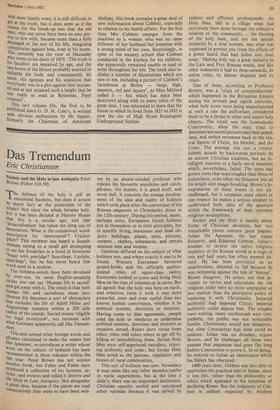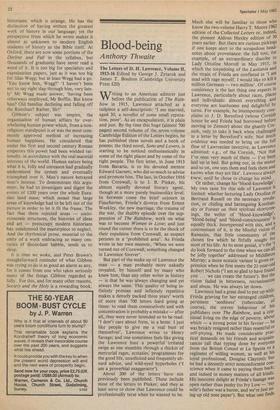Das Tremendum
Eric Christiansen
Society and the Holy in late Antiquity Peter Brown (Faber £10.50)
The defence of the holy is still an emotional business, but does it arouse as much fury as the protection of the whale? Not since the whale became holy. For it has been decided at History House that this is a secular age, and that desacralisation' has taken the sting out of desecration. What is the commonest word- association for 'desecration'? Cricket- pitch? This reviewer has heard a Scotch- woman saying to a small girl attempting to eat her breakfast in a hotel at Inverness Sugar with porridge? Saacrilege, Lavinia, saacrilege', but he has never heard that Word used in a sermon.
The holiness-words have been devalued by over-use. In most English-speaking circles you can say 'Human life is sacred' and get away with it. The result is that both human life and sacredness mean less. Human life becomes a sort of abstraction that excludes the life of Adolf Hitler and Argentinian matelots within a 200 mile radius of the islands. Sacred means 'eligible for legal protection', not resonant with what Germans apparently call Das Tremen- dant This and several other foreign words and Phrases calculated to make the reader feel Der Ignorant, re-introduces a writer whose work on the subject of holiness has been recommended in these columns within the last year. Peter Brown has not written another book, but Faber and Faber have Produced a collection of his lectures, ar- ticles and reviews and called it Society and the Holy in Late Antiquity. Not altogether a good idea, because if the pieces are read consecutively they seem to have been writ-
ten by an absent-minded professor who repeats his favourite anecdotes and catch- phrases. No matter; it is good stuff, and never dull. It concerns the strange develop- ment of the idea and reality of holiness which took place after the conversion of the Roman emperors to Christianity down to the 12th-century. During this period, many, perhaps most, Europeans found holiness not in themselves or in their principles, but in specific living, inanimate and dead ob- jects: buildings, places, texts, pictures, corpses , clothes, substances, and certain unusual men and women.
Opinions differed on the subject of what holiness was, and where exactly it was to be found. Western Europeans favoured gospel-books and the officially authen- ticated relics of upper-class saints; Easterners looked to icons and living Holy Men on the tops of columns or in caves. But all agreed that the holy was here on earth, and whatever form it took it was more powerful, pure and even useful than any known human contrivance, whether it be political systems, doctrines or interests. Having come to that agreement, people used the holy to reinforce or undermine political systems, doctrines and interests as occasion served. Rulers drew virtue from relics; relics told rulers where to get off by killing or immobilising them. Syrian Holy Men were self-appointed outsiders, reject- ing authority and order; but Syrian Holy Men acted as the patrons, regulators and bosses of rural communities.
This sort of holiness was new. Nowadays it may seem like any other mumbo-jumbo or rustic superstition, but at the time it didn't; there was an important distinction. Christian sanctity outbid and outclassed other varieties because it was served by jealous and efficient professionals: the Holy Man 'did in a village what had previously been done through the collective wisdom of the community.... the blessing of the holy man, and not the amulet prepared by a wise woman, was what was supposed to protect you from the effects of a green lizard that had fallen into your soup.' Making holy was a great industry in the Late and Post Roman world, and like other industries it had its shop-stewards, its union rules, its labour disputes and its crises.
One of these, according to Professor Brown, was a 'crisis of overproduction' which happened in the Byzantine Empire during the seventh and eighth centuries, when holy icons were being manufactured at such a rate the authorities considered them to be a threat to other and senior holy objects. The result was the Iconoclastic Controversy, when the state tried to deconsecrate sacred pictures and their guard- ians, and switch reverence back to the cen- tral figures of Christ, his Mother, and the Cross. The attempt was not a crypto- Islamic assault by backwoods puritans on an ancient Christian tradition, but an in- telligent reaction to a fairly novel situation which, nevertheless, failed. The icons had grown roots that were tougher than those of iconoclasm, even when the Emperor put all his weight into image-breaking. Brown's in- terpretation of these events is not un- challenged, but it surpasses most others in one respect: he makes a serious attempt to understand both sides of the question within the framework of their common religious assumptions.
Society and the Holy is mostly about forms of Christian devotion, but two remarkable pieces concern great pagans: Julian the Apostate, the last pagan Emperor, and Edmund Gibbon. Julian's attempt to reverse the entire religious tendency of the Roman world in a reign of two and half years has often seemed ab- surd. He has been portrayed as an anachronism, doomed to fail because he was swimming against the tide of 'history'. Brown disagrees. He points out that at- tempts to revive and rejuvenate the old religious order were no more unpopular or less realistic than the alternative policy of replacing it with Christianity. Imperial authority had imposed Christ; imperial authority could depose him. The temples were waiting, many intellectuals were sym- pathetic, the public was not noticeably hostile. Christianity would not disappear, but what Constantine had done could be undone. Julian was no dreamer, argues Brown, and he challenges all those who assume that paganism had gone flat long before Constantine to prove it. In so doing, he restores to Julian an importance which his failure has obscured.
1400 years later, Gibbon was also able to appreciate the practical side of Julian, since it was this, rather than his philosophy or ethics which appealed to the historian of declining Rome. But the judgment of Gib- bon is seldom respected by modern
historians: which is strange. He has the distinction of having written the greatest work of history in our language; yet the perspective from which he wrote makes it almost as unknown to modern English students of history as the Bible itself. At Oxford, there are now some portions of the Decline and Fall in the syllabus, but thousands of graduates have never read a word of it. It is too big for specialists and examination papers, just as it was too big for Silas Wegg; but at least Wegg had a go. `You know him, Wegg?' 1 haven't been not to say right slap through him, very late- ly' Mr Wegg made answer, 'having been otherways employed, Mr Boffin. But know him? Old familiar declining and falling off the Rooshan? Rather, Sir!'
Gibbon's subject was empire, the organisation of human affairs by over- whelming human power which, from a non- religious standpoint is or was the most com- monly approved method of increasing human happiness. He considered that under the first and second century Roman emperors this power had been wielded rat- ionally, in accordance with the real material interests of the world. Human nature being what it is, folly and unreason had gradually undermined the system and eventually triumphed over it. Man's nature betrayed man's interest. To demonstrate this argu- ment, he had to investigate and digest the events of 1200 years over the whole Eura- sian land mass; which meant that large areas of knowledge had to be left out of the picture in order to let it fit the frame. The fact that these rejected areas — socio- economic structures, the histories of ideas and art — preoccupy modern historians has condemned the masterpiece to neglect. And the rhythmical prose, essential to the unity of a work embracing so many cen- turies of discordant babble, sends us to sleep.
It is time we woke, and Peter Brown's straightforward reminder of what Gibbon was trying to do is as good an alarm as any, for it comes from one who takes seriously many of the things Gibbon regarded as folly. For this, and for many other reasons, Society and the Holy is a rewarding book.







































 Previous page
Previous page